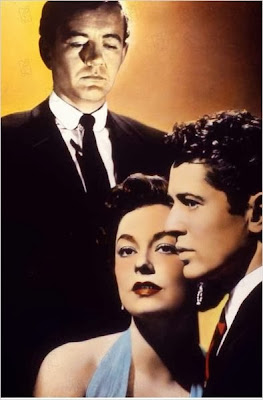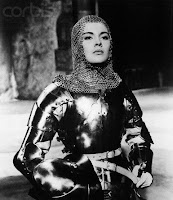The murder mystery has been a movie staple since the silent era. In the 1930s variations on the drawing-room style whodunit, perhaps epitomized by the lighthearted Powell/Loy “Thin Man” series and the suspenseful Rathbone/ Bruce “Sherlock Holmes” franchise, became popular. Fairly standard in these mysteries was a group of people in a remote location where one (or more) of them is murdered; the killer was not, in most cases, unmasked until the last act. One of Agatha Christie’s most popular whodunits, written in 1939, was filmed by Rene Clair in 1945 as the memorable And Then There Were None, starring Walter Huston and Barry Fitzgerald. But the “cozy” whodunit has never entirely gone out of style and an updated variant, the whodunit with an all-star cast emerged. This tale concerns one such film, a clever and absorbing entry from the era of “Easy Riders and Raging Bulls,” and how it came to be…
 |
| Anthony Perkins |
During the late 1960’s actor Anthony Perkins, synonymous with Psycho’s Norman Bates, lived in Manhattan and was part of composer/lyricist Stephen Sondheim’s social set. Sondheim, a Broadway legend among whose masterworks is Sweeney Todd, shared many interests with Perkins, one of which was a love of sophisticated games and puzzles. Sondheim was well known at the time for his own rendition of the “murder game,” an at-home version of the whodunit, and was famous for going to great lengths to ensure his players really experienced “a certain amount of fear …” Writer Peter Shaffer (Amadeus) was so dazzled after playing that he asked Sondheim to stage a game in London at the home of his twin brother, Anthony (Frenzy, Death on the Nile ). The London game later inspired Anthony Shaffer to write Sleuth.
 |
| Stephen Sondheim |
A scavenger hunt Sondheim and Perkins cooked up for Halloween 1968 became legendary. It had taken the two friends a full month to plan the “Eleanor Clark French Memorial Treasure Hunt,” to which they invited several famous friends (including Roddy McDowall, Lee Remick and Herb Ross). The group of twenty would spend the night roaming, in limousines with maps, all over Manhattan in search of clues. Eventually Sondheim and Perkins got together and wrote The Last of Sheila. A whodunit about an elaborate – and murderous - game, the story became a 1973 film directed by Herb Ross and was studded with stars James Coburn, James Mason, Raquel Welch, Dyan Cannon, Richard Benjamin, Ian McShane and Joan Hackett. Perhaps relishing the opportunity to satirize the movie business, Sondheim and Perkins created characters, both cutthroat and cowardly, straight out of Hollywood.
The Last of Sheila begins with the hit-and-run death of Sheila Green, a gossip columnist (briefly played by Yvonne Romain, formerly of B-movies and still the longtime wife of writer/composer/lyricist Leslie Bricusse). A year later her husband, ruthless producer Clinton Green (James Coburn) invites a group of industry associates to join him for a week-long Mediterranean cruise on his yacht, the Sheila. In attendance is a variety of industry types – director, actress, screenwriter, agent - each in need of Clinton in one way or another. Once all are on board, he reveals that he’s devised "The Sheila Green Memorial Gossip Game" as an entertainment during the trip. However, the devious exec’s true motive is to expose his wife’s killer in public; all six of his guests had attended a party at his home the night Sheila died - and the vengeful producer knows her death was no accident. However, as the game develops, his plan goes awry…
The convoluted cat-and-mouse thriller had originally been set on a snowbound estate on the East Coast. But filming on the Riviera seemed much more appealing to all and the estate was transformed into a luxury yacht. As it turned out, the change in location led to major difficulties…
· For starters, the yacht chartered for location shooting sank off the coast of Greece on its way to France. A replacement was quickly found but it wasn’t as large as the original and this caused delays and additional expense when interior sets had to be rebuilt.
· Then there were bomb threats from the Arab terrorist group Black September, apparently in protest of Jews working on the project.
 |
| Sue Mengers and Jack Nicholson |
Not so much a problem for the production but a challenge for the actress,Dyan Cannon was asked to gain weight for her role. Putting on pounds might have been a worrisome proposition, but equally daunting may have been that her character, a blatantly bitchy and profane talent agent, was based on her own (and Perkins’s) agent at the time, the powerful Sue Mengers.
Super-agent Mengers had arrived in Hollywood from New York just in time for the “decade under the influence.” She’d started in the agency business as an MCA receptionist in 1955. Working her way up and around, she departed for the West Coast in 1968 and, at CMA, joined the once exclusive boys club of Hollywood talent agents. Soft-faced, zaftig and very blonde, Mengers played hardball with the best of them. She developed a reputation for her parties, her pot, her foul mouth and her sense of humor – but most of all, she was acknowledged for her mastery of the art of the deal. Time Magazine called her “a cross between Mama Cass and Mack the Knife.” Mengers was at her apex when The Last of Sheila came out, with a client list that included not only Cannon and Perkins but also Streisand, McQueen, Burt Reynolds, Mike Nichols, Faye Dunaway, Ali McGraw and a long list of other in-demand stars of the new Hollywood.
Cannon, a deft comedienne, bravely soldiered on and her performance as the brassy virago was the picture’s stand-out turn and earned the actress much critical praise.
 |
| Raquel Welch |
Playing the part of a Hollywood sexpot was Hollywood sexpot Raquel Welch. Anthony Perkins thought she was the most physically perfect woman he’d ever seen, and he was not alone. The former beauty queen/weather girl was in her early 30s then and one of the hottest stars in Hollywood. She’d begun to develop a reputation as difficult to work with and the Sheila set may have been one of the sources of her tag as a diva. At one point she walked off the set claiming director Ross had attacked her. James Mason, highly respected for his then nearly 40-year career, commented publicly that Welch was the most inconsiderate actress he’d ever worked with. Perkins remarked, “She really should have done it closer to when the picture actually opened when something like that in the paper would have done the picture some good.”
Though sprinkled with stars, laced with sly humor and plot twists, and appreciated by critics from Vincent Canby to Roger Ebert, The Last of Sheila was not a box office hit. It would be one year later, with Sidney Lumet’s adaptation of Agatha Christie’s Murder on the Orient Express, that the star-studded whodunit would gain a wide audience.Though Sheila was ignored by the Academy, Sondheim and Perkins’s screenplay won an Edgar Award from the Mystery Writers of America.
Turner Classic Movies is featuring guest programmers on Mondays and Thursdays throughout the month of March, and this time the group has been selected from TCM's own staff. Alexa Foreman of the Studio Production team chose The Last of Sheila and described it as, “a mystery that few have heard of, even though it was written by Stephen Sondheim and Anthony Perkins, and may be the best-cast movie ever.”
I was not familiar with The Last of Sheila the first (and last) time I saw it, which was years ago on television. At first I was mostly curious to see a film I didn't know about that boasted an all-star cast. But I love a mystery and quickly became engrossed in a tricky plot enhanced by barbed dialogue and a sinister undercurrent.
TCM’s screening of The Last of Sheila will be its premiere on the classic movie channel. The film has developed a cult following among murder mystery lovers over the years and currently has a 91% positive rating from critics at Rotten Tomatoes. I'm looking forward to seeing The Last of Sheila for the first time in a very long time and will be thinking of Stephen Sondheim as I watch...the incomparable Mr. S will be celebrating his 81st birthday on March 22...
The Last of Sheila will air on TCM on Thursday, March 31, at 10:30pm Eastern/7:30pm Pacific (it is currently available to Comcast customers On Demand under Premium Channels/Preferred Collection)



































